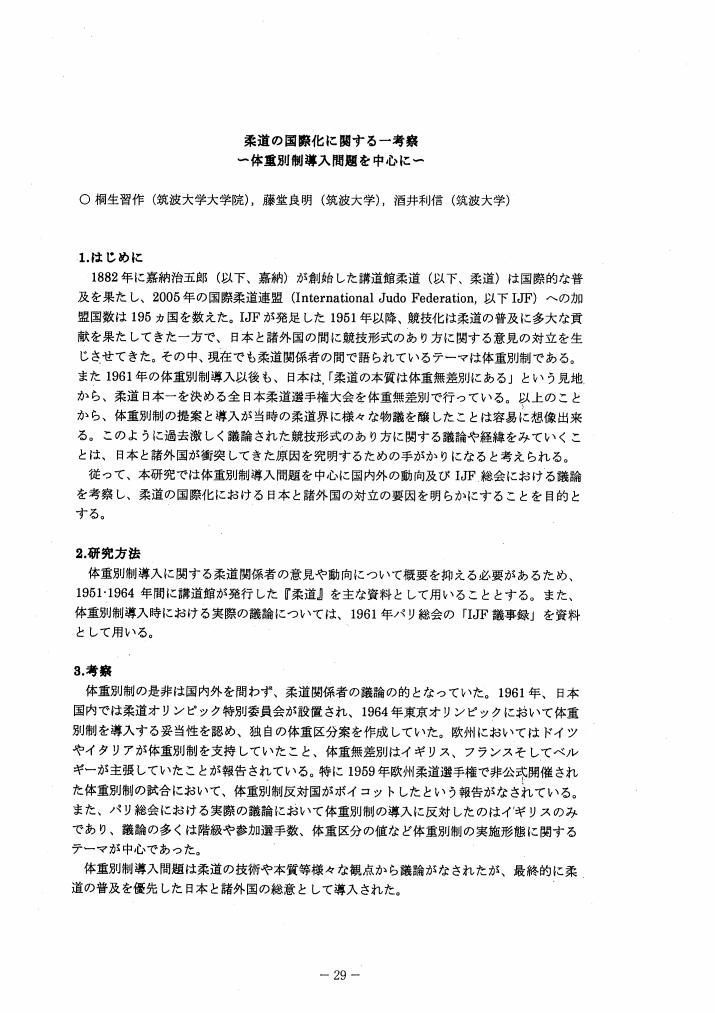- 著者
- 桐生 習作 村田 直樹 藤堂 良明
- 出版者
- 日本武道学会
- 雑誌
- 武道学研究 (ISSN:02879700)
- 巻号頁・発行日
- vol.45, no.2, pp.119-133, 2012-12-25 (Released:2014-04-04)
- 参考文献数
- 57
Throughout the course of the popularization of judo, Jigoro Kano refined kitoryu-no-kata (a technique in judo having a profound theory) and developed it as koshiki-no-kata. The purpose of this study is to clarify: (1) the details of kitoryu-no-kata, (2) the development from kitoryu-no-kata to koshiki-no-kata, and (3) Kano’s strategies on the popularization of kata as to which parts of kitoryu-no-kata he valued the most, the methods of the development of kitoryu-no-kata, its meaning and the development from kitoryu-no-kata to koshiki-no-kata. The results are shown below:(1) Kitoryu is based on a state of unity between the imperturbable mind and body, which is called hontai. According to the Kitoryu jujutsu code, hontai places a strong empathies on spiritual training and harmonizing the mind and body with the universe’s energy source — ki, without being distracted by the moves of the kata or the opponent’s moves. In establishing Kodokan judo, Kano adopted kitoryu-no-kata (grappling techniques in armor which was used in times of war), as a kata with noble principles. In the kitoryu-no-kata style, Kano valued a steady posture (hontai), an imperturbable mind and techniques that disturb the opponent’s posture.(2) Kano changed the name from kitoryu-no-kata to koshiki-no-kata sometime after 1901. When comparing the two kata, it can be seen that there are five waza (techniques) that acquired a different name and two waza (techniques) that have a reverse order. In the Kitoryu style, a 14-technique session begins and ends with a courtesy greeting. In the Kitoryu style, 14 techniques and seven mudan techniques have been recognized as different forms of kata. Although there is a movement that disturbs the opponent’s posture by grasping and holding his neck in the kitoryu-no-kata style, Kano changed it to pressing against the opponent’s chest instead— from the point of view of safety and elegance.(3) Ever since the very founding of Kodokan, judoka have been neglecting kata. Kano tried a variety of ways to popularize kata because he felt that students should learn the principles of correct throwing techniques through kata.
1 0 0 0 OA 柔道専門分科会
1 0 0 0 OA 柔道の国際化に関する一考察
1 0 0 0 OA 〈プロジェクト報告〉大学柔道選手における鼻腔内黄色ブドウ球菌の保菌状況
- 著者
- 桐生 習作 小倉 武蔵 村瀬 陽介
- 出版者
- 筑波大学体育センター
- 雑誌
- 大学体育研究 (ISSN:03867129)
- 巻号頁・発行日
- no.35, pp.75-85, 2013-03
1 0 0 0 OA 〈報告〉 集中実技東洋的身心鍛錬法新設
- 著者
- 桐生 習作 向後 佑香 松倉 啓太
- 出版者
- 筑波大学体育センター
- 雑誌
- 大学体育研究 (ISSN:03867129)
- 巻号頁・発行日
- no.35, pp.69-74, 2013-03

